
Stove Top Debacle
Let me start by saying that I have always thought of my self as the kind of guy who when faced with a self made disaster, would take credit for it. My reply on another thread that I thought stove top baking in a dutch oven is possible, is why I'm posting my trial bake. Not everything I try is beautiful, as you can see. I think I learned enough to make corrections in the burner level and have a better result. Who ever said you can't really burn bread hasn't tried this method.
This is a 68% hydration French style Pain au Levain. I made enough dough for 2 loaves baked at the same time. The fire detectors didn't alarm, better check the battery!
Enjoy my disaster.
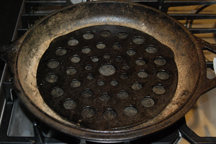
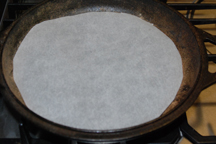
Cast iron trivet to hold dough off the bottom. Parchment to hold dough.
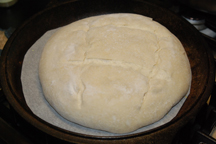
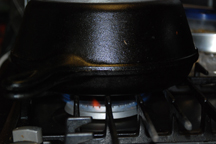
Slashed and ready to cover. Cover on holding 320F +~-
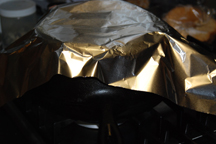
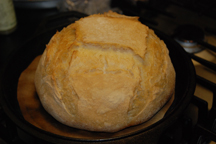
Tented to hold heat in on top. This seemed to work.
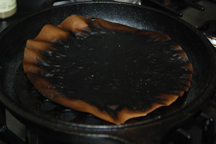
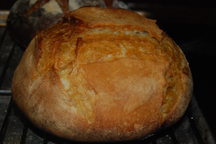
Parchment was scorched from medium burner heat. The crust is very thin and some of the color is from the burning of the bottom.
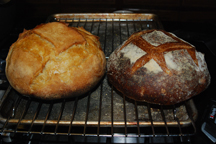
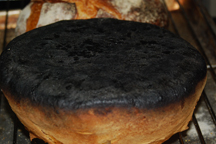
I made 2 loaves. One for the oven and one for the combo cooker. The bottom of the DO loaf was carbonized. Evidence of way to much burner heat.
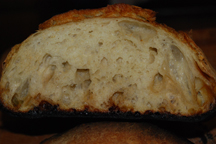
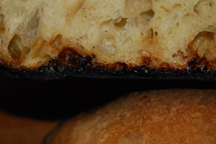
The blackened bottom made the crumb inedible in a civil world. I am pleased with the crumb structure and over all profile.


Comments
Lol, but on a camping trip that bread would be sheer heaven. I have baked like this on camping trips and outdoor barbecues before. I raise the dutch oven off the coals using a trivet and then strategically place a few coals on the lid to provide top heat. It has always worked very well. Never tried it on the burner. Looks like you are going to have to do some experimenting with regards to how high you need to raise it off the flame and what size of flame is ideal.
Nevertheless, if you cut away the burnt part, I am sure it is a very tasty loaf. Nice height and open crumb.
The trivet you have to keep the dough off the bottom is in contact with the bottom of the dutch oven and consequently it will get just as hot as the dutch oven, so it is not going to provide much measure of protection. At best, it will just delay the inevitable. You need something to raise the bottom of the dutch oven off the flame (I would say at a height of at least 2 inches).
Was the crumb cooked through?
Sincerely,
Syd
Nice experimentation, Eric! I agree with Syd. Couple of notches higher and you may have succeeded.
or did the burned bottom one have better spring? i think syd is right -- a camping DO with feet and lid to hold coal would've done it. but if i had the combo cooker, i might be tempted to let the oven spring happen on stove top and then move the loaf into the oven to finish. wow, that oven spring!
Eric,
That crumb looks great. Just remember where the term "upper crust" came from.
In an earlier era I struggled with campfire DO cooking and baking until I learned--as countless camp cooks before me--not to let the coals touch the bottom. Even though camp Dutch ovens are fitted with legs, we'd dig a shallow pit under them to prevent coals touching, while at the same time, providing radiant heat. I'd suggest, if you want to persue this further, acquire a DO with legs that will straddle, but not touch the burner. If your cooktop is gas you can also buy a flame shield--a cast metal disc that sits over the burner and prevents flame from touching the bottom. They are inexpensive.You would still need to raise the DO, preventing its bottom from touching the flame shield. Syd is spot on with his comment about the trivet not providing much protectiion.
We ultimately learned how to manage camp DO cooking, and enjoyed years of camping weekends with some great tasting food and bread, sans burnt taste. Now my idea of "roughin' it" is no ice for my gin and tonic.
David G
Interesting experiment. It sure is food for a curious soul, like myself.
Sue
http://youcandoitathome.blogspot.com/
turn the loaf halfway through ?
anna
Yes Anna, I think you could turn it with a spatula. That might result in a little actual crust on top. Thanks,
Eric
Maybe you could use a larger piece of parchment paper with edges extending on the sides of the loaf which could be used to lift out the loaf, turn it, and carefully lower back into the pot.
Also a springform, a bit larger than the bottom of the pot could be the answer.
It would be quite a bit off the bottom, easy to take out and lower back in.
anna
Syd, and others,
The trivet has little legs protruding on the bottom that keeps it off the bottom. I was thinking that a small amount of air between the bread and the bottom of the CC would result in a perfect bottom. Others have said the heat should be at low and the trivet should be under the DO. I'll try again using that configuration.
I was amazed at the condition of the bread when I removed the cover after 20 minutes. I had been watching the temperatures with the IR temp gauge and had adjusted the flame to maintain something over 300F on the lid. I had pre heated both top and bottom to 400F before loading and closing. When I removed the cover after 20 min, the loaf had bloomed beautifully but was very pale. I reheated the cover on my wok burner and replaced it, then covered with foil to slow heat loss. The objective was to create a hot environment on top so the crust would color in a closed container. Ideally I think a vent in the top would be the answer if I were going to do this regularly.
I've done lots of DO cooking and baking in the field using coals on the top for browning and elevated the DO off the fire. In retrospect, a slab of steel plate under the DO might be a good idea as Syd suggested. That would create a larger amount of thermal mass and a buffer from direct flame. I'm also thinking about creating a vent for the final time period by setting the cover ajar. The internal temperature was 210F after 30 minutes to my surprise. The crumb was fully baked but essentially there was no crust to speak of. The color was the smoke particles adhering to the surface (think-a house fire where everything is covered with soot lol)
Eric
What about adding some water in the bottom? It would help to steam it and maybe once the water evaporated the bread would be risen and would bake with less damage to the bottom. This is just a guess. I am surprised that the parchment didn't catch on fire.
When I removed the parchment, it came out in pieces, all black and burned. Limited oxygen probably prevented actual flames. It didn't need water I don't think. The moisture in the dough made for a humid environment. I re-seasoned the inside of the DO this morning but it wasn't bad.
This is the kind of curiosity that got me into so much trouble as a kid. My poor mother.
Eric
Hi Eric,
When in Boy Scouts many years ago we regularly baked pies, cobblers, pizza, nachos and breads with great success- after many failures! We used a 12 quart three legged Dutch iron (13" diameter, so about 12" inside diameter). We would place three small stones or bottle caps inside near the outter edge and then bake in a cake pan or pizza tray that would sit solidly on top of the stones. This kept the baking dish off of the heated bottom and provided hot air circulation all around the pan. We also had success with cobblers where the filling would be placed directly in a cold oven followed by a batter crust on top. We needed slightly less coals but usually had good results there too. Less rather than more coals led to the best results whether directly in the oven as in a cobbler or indirect if using a pie or other pan. Yes we burned the tops if fully loaded the top of the oven with 14 or so briguettes. So we learned over time and experience.
We would cook down the fire until we had small coals, then remove some with a shovel and place on the ground. Or used charcoal briquettes – a 1 inch layer on the ground and about 8 briquettes on the rimmed lid easily gave a 400°F temp. More coals than this would cause the top and bottom to burn.
So getting the same approach on a stove top with the dough directly placed into the oven rather than in a pan is certainly a very intriguing challenge. Your top looked great, so the bottom is the obvious challenge. And getting all to about a 450 temp as is typical in a combi-cooker.
Suggest the following:
1. Another good way to diffuse and even out the bottom heat is to use a 12” cast iron frying pan on the burner, place the oven inside. Effectively giving a double cast iron layer on the bottom. Even at simmer before long there will be a large heat build up.
2. Alternatively move the oven higher up and away from the flame by 1 1/2". By taking another one of your square burner grates and with a ¼ turn place it on top of the grate/burner you will be using. This will be stable if positioned correctly- if you use one of the grates that's on the opposite side of the stove rather than the one touching the burner you will be baking on.
3. Loosly tent the entire oven with a large square of aluminum foil - with perhaps the need for a dime sized vent hole at the top to allow some of the heat to release out. Sort of like an upside down funnel. This is probably the most critical given the need to get more heat to the top.
4. Set the flame to be somewhere in the middle of where you had it and simmer. Let heat up for 20 minutes to see how the temp feels on top and bottom – Ajust for even heat by raising or lowering the flame/opening or closing the hole in top. Use an oven and laser thermometer to take test readings and adjust accordingly.
Keep us posted!
En=ven though the bottom would kill somebody, it was an interesting experiment. Who knows you might have discovered a better / another way. My hats off for your experimentation!!!If we all do the same thing the same way, there would never be anything new.
So sweet Audra. Lol. When I was a small boy, I recall my mother let me plant some eggs in the garden to grow some egg plants. I couldn't decide if they should go in the ground whole or broken open, so she gave me enough to try both ways, never letting on which way is best. She was always quick to encourage my curiosity which endures today.
Eric
Eric - I gotta' hand it to you, you try things and then unabashedly share the results - the good, the bad and the ugly! Actually I'm amazed at how the loaf rose and how good the top of it looks in color. I'm thinking aluminum foil (heavy duty) and a lower temp and you might produce something that could win you a merit badge in scouting.
Thanks for sharing!
Larry
Hello, Eric
I had the same problem like yours.
But I put the pan in a oven instead. As Syd and Khalid suggested, It is good to have something to lift the dutch oven up.
I used this one.
I put the toaster for camping underneath my pan.
And it worked.
I hope that you can figure it out soon. Nice open spring, Eric!
If the dutch oven had higher height, I would put a celamic flower pot in the bottom of the dutch oven.
Happy baking,
Akiko
Eric,
There's a tool for that. Try a used goods store and take a gander in the woodworking tools bin. There is a very coarse rasp with an offset handle that is often mistaken for a wood rasp. It is, in fact, a bread rasp, whose purpose is to remove the burnt crust(s) from loaves.
Burnt bottoms were common in the days when fireplace hearths, wood fired cast iron ovens, and Dutch ovens were the usual means of baking. Rasping the carbon from the loaf was just part of the process.
cheers,
gary
after reading the 1st paragraph, i thought you totally just made it up. but then the second paragraph showed that you know what you're talking about. and then i googled it and almost bought one on impulse....
on top oaf zee foiel on top oaf zee pot. :)
and my Mom and me....get a diffuser. So simple. No pyrotechniques...no burned bottoms....
Place on the burner to spread and " diffuse" the heat and the problem should be solved. It is available on Amazon. Mine is really old but the newer ones are =. Good Luck and please post when you try again.
I have the toaster as shown above and it does a great job of toasting on the camp stove. He is using it as a diffuser...get a real diffuser...c
We need more moms like yours in the world to encourage their children to be creative!
Yea she was a big help to me. I try to keep in mind how she was with me when dealing with my own kids. Not being afraid to try things has always been a big part of my personality, as you can tell.
Mini: Yes I saw that instruction about the towel. I'm a dummkoph!
Eric
I routinely roast garlic on the stove top in a cast iron DO and have always been curious if one could bake bread on the stove top also (not steamed bread like the Chinese do - that's different).
As I understand it there are 3 main problems -
I do not have an IR temp gauge but I do have a lot of cast iron cookware. I also have something that ehanner may not have - a round cast iron burner ring from my very old gas stove.
Here's my idea for the assembly (feedback solicited) -
use a simmer ring to diffuse heat
use a 5-quart (#8) cast iron Dutch Oven to bake in - but not the lid (reserved for another purpose)
use a #8 cast iron skillet upside-down on the DO as the lid
.
The dutch oven covered with the skillet gives me about 6" interior height to work with. I'll put the round cast iron burn ring in the bottom of the DO (it fits snugly) and on top of that I'll put the cast iron trivet (like the one ehanner has). The burner ring elevates the trivet off the bottom about 3/4" while the trivet will be the base for the dough. This means I still have about 5" interior space to allow for dough + oven spring.
Just to give an idea, the assembly will look something like this from the outside although this is not the actual DO and skillet I'll be using for this experiment. The preheated lid from the DO will be placed on top of the skillet.
To increase the heat on the top, I'm thinking of heating the lid to the DO also and placing it on top of the upside-down skillet at the beginning of the bake. This will (hopefully) mimic the use of coals on the lid of a DO which is typically done for campfire baking.
Without an IR temp gauge I have no way of measuring actual heat, so I need help and suggestions about how long to preheat and how long to bake.
I'm also wondering about the effectiveness of the DO lid on top of the skillet - maybe this should be preheated again halfway through the bake?
Looking for any and all suggestions and feedback before beginning this experiment. Thanks! - SF
=== PS === if you, dear reader, would rather offer your feedback off line, you can always send me a PM
First, more than any other tool I have in the kitchen, I would stop what you are doing and buy a IR temp reader. Amazon has them for around $40 and I use it several times each and every day. Water temp, dough nuke the tap water, oil temp for frying, stone temp, just an incredibly useful tool. I wouldn't be without one.
I agree mostly with your description of the issues as you list them. The "to little heat on the top" is more like , no heat on the top. I think as has been suggested, it might be good enough to insulate the top to retain the heat from the bottom better. Mini and I read about using foil and then a towel placed on top of the lid.
Your diffuser I think is intended to cut the direct heat from the burner so you can simmer without scorching the bottom when braising. A trivet inside the DO does much the same for the meat but not for the inside bottom. The problem as I see it is that in order to generate enough heat to rise and collect in the top, you need a higher heat source for the bottom. Actually, flipping the bread mid point might be a way to get even baking instead of trying to brown the top. A cheap propane torch applied to the top every now and then during the process would probably work but there has to be a limit to the lengths I will go to prove to my wife I actually AM a lunatic. Lol.
As far as pre heating times, there are lots of variables like burner btu's and such that make that difficult. I got both halves hot, especially the top, before loading. I now think my next try will be to use a med-low heat setting on my large burner ( not the wok torch). I will place a trivet under the bottom of the DO and I might place a WOK ring over the burner to raise the DO. This is starting to sound a little shaky so we'll see how it stacks up.
I do think we need to find a way to vent the steam after the initial 20 minutes. Moving the cover ajar slightly might help. Otherwise the crust will be so soft it will resemble a steamed bun as you mentioned.
Let me know what you try here.
Eric